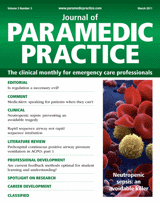References
Spotlight on Research
In this retrospective database analysis, McMullan and colleagues reviewed the Cardiac Arrest Registry to Enhance Survival (CARES) registry for 2011 to determine the influence of airway management approach on rates of sustained return of spontaneous circulation (ROSC), survival to hospital admission, survival to hospital discharge and survival to hospital discharge with good neurological outcome (Cerebral Performance Category 1 or 2).
The CARES registry collates data relating to cardiac arrest from 400 emergency medical service (EMS) agencies across the USA. This analysis included adults (age ≥18 years) and excluded cases where age was unknown or not reported and where airway management data were not reported or the device used was listed as ‘other’. Cases were classified as receiving endotracheal intubation (ETI), supragalottic airway (SGA) insertion or no advanced airway. SGA devices used by participating agencies include King Laryngeal Tube, Combitube and Laryngeal Mask Airway (LA). Cases where ETI or SGA insertion failed were classified as no advanced airway.
Subscribe to get full access to the Journal of Paramedic Practice
Thank you for visiting the Journal of Paramedic Practice and reading our archive of expert clinical content. If you would like to read more from the only journal dedicated to those working in emergency care, you can start your subscription today for just £48.
What's included
-
CPD Focus
-
Develop your career
-
Stay informed

